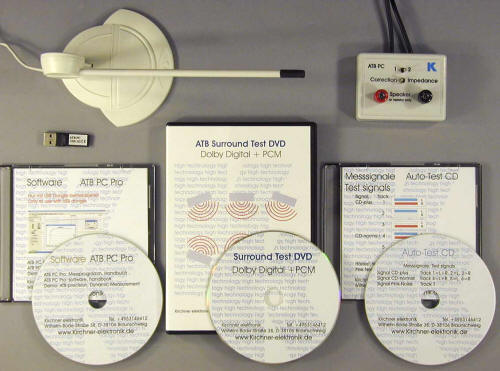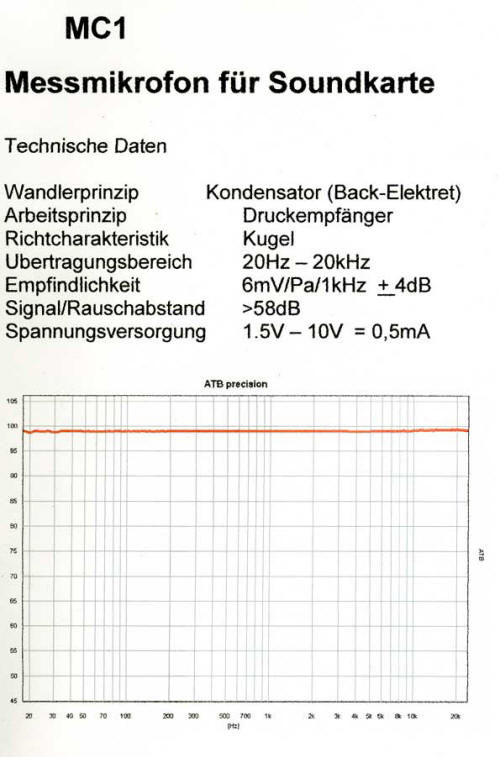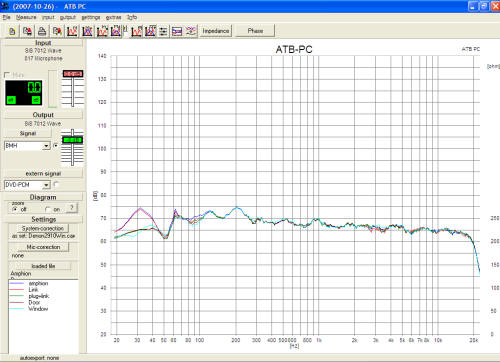You are reading the older HTML site
Positive Feedback ISSUE
january/february 2008
kirchner elektronik
ATB Pro PC Audio Analyzer System - Room to Measure
as reviewed by Bruce Kinch

|
BRUCE KINCH'S SYSTEM
LOUDSPEAKERS
ELECTRONICS
SOURCES
CABLES
ACCESSORIES
|
It is my lot to listen in a lousy room in a lovely home…
It is also a prime audio-phorism that the room is the most important component in a system. And there are certainly plenty of traps, tubes, panels and "tuning" widgets on the market intended to enhance the listening experience. But most of these are designed to affect middle and high frequencies, where controlling the acoustic properties of reflection, diffusion, and absorption of non-direct sound can usefully improve overall tonal balance and imaging. Where the Spousal Acceptance Factor (SAF) predominates, carpeting, drapery, bookshelves, potted plants, and cushy furnishings can often be nearly as effective, anyway.
Below about Middle C (261Hz), however, it is the actual dimensions of the room that wreak the most havoc. These are the notorious resonant frequency standing waves, also known as room modes, or eigenmodes if you want to get technical. Few "room treatments" can ameliorate them. You can, however, compute them: the sound resonates, or repeatedly reflects at particular frequencies when the distance between the room boundaries corresponds to an integral number of half wavelengths of the sound. Easier though, to go to www.hunecke.de where you can plug in room dimensions to find the first 20 room modes, visualize the frequency distribution, and see how each affects the listening position in a simple room diagram. The shaded areas are where the sound peaks in loudness, the white where there are nulls. Just convert your dimensions to meters (a foot is .305 meters).
My golden years as an audiophile were spent in what might be George Cardas' Utopian Ideal, a large shoebox-shaped room in a Boston area Colonial that hewed very closely to his Golden Ratio concept—where the room dimensions differ by a factor of 1.618. A bit like Boston's Symphony Hall it was, and sounded like it. A simple Golden Ratio room might follow the Fibonacci series—for example, a room that is about 8' h x 13' w x 21' d:

Although the higher modes above 125Hz are so close as to be indistinguishable (which is normal), there is reasonably even spacing below, which is critical.
Since moving to New Mexico, I've been dealing with an almost worst-case room, where the width and depth are almost the same, and the ceiling height is almost half the other dimensions. Here is my room:

Note the double modes around 31.5, the two broad nulls before 63, and the lumpy distribution above that. If you plug my dimensions (or yours) into the Hunecke page, you can click each mode to see how it affects the bass distribution for any seating position. Yes, we all have bass issues, but they are exacerbated here by the fact the preferred construction in these parts is adobe. Unlike conventional drywall rooms, where bass can be almost as loud outside as in, there is almost zero bass leakage through adobe. In other words, there is more "room lift" of lower frequencies as bass frequencies decay slowly.
So I've spent hours with my Radio Shack Sound Level Meter, pushing around speakers and furniture. With little improvement. Or much recourse. Many audiophile sites and mags are measurement free zones—sorry, I meant sophisticated, subjective salons of sonic splendor. Stereophile is a notable exception; what I understand about speaker measurement I largely owe to John Atkinson's efforts, especially where his findings contradict the prosody of the reviewer. Of course, his approach is designed to eliminate room effects while assessing speaker performance, just as manufacturers tend to develop their designs in anechoic chambers. So choosing a speaker on even JA's specs without understanding how it interacts with your room is not unlike choosing a mate via an internet dating site. You might get lucky. Or not.
I was mulling over this conundrum after playing the same CD through a dozen odd setups at the 2007 Rocky Mountain Audio Fest. And I mean odd, as it sounded different each time. And while I had a bag full of glossy lit pieces to show for the experience, what suddenly piqued my interest was a simple Xeroxed sheet from Meniscus Audio I chanced to pick up off a table. Which is how I discovered the ATB Pro PC Audio Analyzer system. Developed by Kirchner Elektronic of Germany (www.kirchner-elektronik.de/gb-atb-pc-pro.php) primarily for speaker-building hobbyists and car and home theater installers, it allows anyone with a Windows PC to make accurate frequency, phase, step response, impedance and distortion measurements. All for less than the cost of a decent pair of interconnects ($219 show special at the RMAF, but given the Dollar-versus-Euro dance, better check with Meniscus Audio, www.meniscusaudio.com/). There's even an optional tape-on accelerometer for vibration treatments.
Now, I've been a Mac guy since forever, primarily because I like digital photography, but the wife had an aging Windows laptop with a dead battery lying around free for the taking. There are sound measurement programs for the Mac, but the ATB Pro PC is a neat, integrated, closed-loop system. That is, in addition to the software program, it is designed around a specific microphone and pink noise test signals on CD (stereo) and DVD (home theater) discs. The microphone is plastic and quite unimposing, but whatever response quirks it might have apparently get factored out in the companion software.

Software installation is quite straightforward, although you have to use a USB dongle. There are simple steps to calibrate the CD or DVD player and the computer sound card, and you are set to go.
I'll not go into the full capabilities of the system here. I'm not an amateur speaker builder, and our home theater is at least a year from construction, so I'll stick to basic speaker measurement. There is plenty of info on all aspects at the Kirchner site if your interests are broader than mine, although the English translation is not always idiomatic. This is also true of the PDF software documentation, but actually making measurements is quite straightforward. Load the CD, select the track (L, R, Stereo), hit play and click the M button, and the frequency response is displayed a few seconds later. Move the mic or speaker and click the M+ button, and the second and up to 30 additional curves can be drawn. Click the M Continuous button and the curve keeps refreshing as you move microphone or speaker around. A real-time, high-resolution audio-analyzer, I mean how cool is that?
You can save, average, and print the curves. You can test in close proximity to a driver, at a standard 1-meter distance, or at the listening position (my preference). Compare L and R speakers, or see how they sound together. Test the drivers and port separately and splice the curves. You can change the parameters of the display without losing data. Expand or contract the dB measurement range, for example. The raw in-room curve can be quite chaotic—room reflections dominate, giving a hint of what kind of work the ear/brain processing must do. To approximate that, you have a choice of smoothing the curve to 1/24, 1/12, 1/6, 1/3, ½, and 1 octave bands. Using the step function, you can adjust the rake of the speaker to optimize the driver time alignment for the ear position.

The screen shot example shows a set of curves from my Amphion Xenon loudspeakers, left channel taken from the listening position with 1/6 octave smoothing. The peaks at 31.5Hz and the null at 50Hz predicted by the Hunecke calculator are clearly visible, as are the peaks at 60Hz, 120Hz, and their multiples. The lower curves below 50Hz show the effect of stuffing the port with the Amphion-supplied foam plug. The spread-out curves between 60 and 100Hz, their bass-adjusting jumper link and the effect of opening the door and a window to the room, thus letting a bit of bass out of the adobe box.
Trust me, I learned more about why my speakers behave the way they do in my room in an hour with the ATB Pro PC than I had by blind experimentation over the past two years. And it was a lot more fun. The changes I made were not drastic—moving the listening axis a bit off the room's geometric centerline, bringing the speakers forward and a bit closer together, and moving the listening position back a like amount. But the improvement was as unmistakable to the ear as it was on the display. Highly recommended! Bruce Kinch
Kirchner Elektronic
web address:
www.kirchner-elektronik.de
